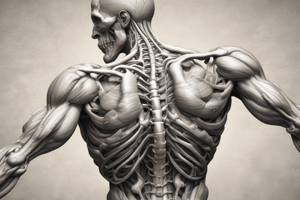Podcast
Questions and Answers
What is the primary function of the sinoatrial (SA) node in the heart?
What is the primary function of the sinoatrial (SA) node in the heart?
- It regulates the brain's signals to the heart.
- It propels blood into the lungs.
- It generates electrical signals that set the heart's rhythm. (correct)
- It acts as a muscle contraction initiator in the ventricles.
How do cardiac muscle cells differ from skeletal muscle cells concerning nuclei?
How do cardiac muscle cells differ from skeletal muscle cells concerning nuclei?
- Cardiac muscle cells have multiple nuclei while skeletal muscle cells have one.
- Skeletal muscle cells have two nuclei while cardiac muscle cells have one.
- Cardiac muscle cells have one to two nuclei per cell while skeletal muscle cells are multinucleated. (correct)
- Both cardiac and skeletal muscle cells contain one nucleus per muscle fiber.
What initiates the conduction of electrical signals through the heart after they leave the sinoatrial node?
What initiates the conduction of electrical signals through the heart after they leave the sinoatrial node?
- The atrioventricular (AV) node generates the signals.
- The brain regulates the initiation of signals.
- The Purkinje fibers distribute the signals.
- The Bundle of His transmits the signals to the ventricles. (correct)
What type of contraction characteristics does cardiac muscle exhibit?
What type of contraction characteristics does cardiac muscle exhibit?
Which of the following statements accurately describes the innervation of cardiac muscle?
Which of the following statements accurately describes the innervation of cardiac muscle?
What type of muscle is primarily responsible for voluntary movement?
What type of muscle is primarily responsible for voluntary movement?
Which characteristic is NOT associated with smooth muscle?
Which characteristic is NOT associated with smooth muscle?
Which type of muscle fiber is known for its fatigue resistance?
Which type of muscle fiber is known for its fatigue resistance?
What is the primary function of troponin and tropomyosin in muscle contraction?
What is the primary function of troponin and tropomyosin in muscle contraction?
What unique feature facilitates cardiac muscle's ability to quickly transmit action potentials?
What unique feature facilitates cardiac muscle's ability to quickly transmit action potentials?
What causes fatigue in skeletal muscles?
What causes fatigue in skeletal muscles?
Which type of muscle lines organs such as the digestive tract and bladder?
Which type of muscle lines organs such as the digestive tract and bladder?
How do cardiac muscle cells differ from skeletal muscle cells?
How do cardiac muscle cells differ from skeletal muscle cells?
Flashcards are hidden until you start studying
Study Notes
Muscle Types and Characteristics
- The body contains three main types of muscle: skeletal, cardiac, and smooth.
- Skeletal muscle enables voluntary movement, controlled by the somatic nervous system, identifiable by its striated appearance and multiple nuclei.
- Muscle fibers in skeletal muscle are classified into slow-twitch (type I) and fast-twitch (type II) fibers.
- Slow-twitch fibers are abundant in myoglobin and mitochondria, allowing for slow contraction and resistance to fatigue.
- Fast-twitch fibers contract quickly but tire rapidly due to reduced myoglobin content.
- Muscle fatigue arises from oxygen debt: a discrepancy between oxygen needed for ATP production and oxygen supplied via breathing.
- Contraction of skeletal muscles aids in blood and lymph circulation by compressing surrounding vessels.
- The sarcomere is the fundamental unit of skeletal muscle, made up of thick (myosin) and thin (actin) filaments known as the contractile apparatus.
- Troponin and tropomyosin are regulatory proteins that facilitate muscle contraction in conjunction with actin and myosin.
- The sarcoplasmic reticulum stores Ca²⁺ ions, which are critical for muscle contraction.
Smooth Muscle
- Smooth muscle operates involuntarily, regulated by the autonomic nervous system, and is found in organs such as the digestive tract, bladder, uterus, and blood vessels.
- It aids in the transport of materials through peristalsis.
- Lacks organized sarcomeres, resulting in no striations and contains a single nucleus.
- Unique myogenic activity allows for contraction independent of nervous system input, often associated with a "second brain" in the gut.
Cardiac Muscle
- Cardiac muscle, found exclusively in the heart, possesses characteristics of both skeletal and smooth muscle.
- It is striated like skeletal muscle and contains sarcomeres but functions involuntarily, with typically one to two nuclei per cell.
- Intercalated discs connect cardiac muscle cells and contain gap junctions for rapid ion flow and quick action potential propagation.
- This interconnectivity facilitates synchronized contraction across the heart tissue.
- Cardiac muscle also exhibits myogenic activity, allowing it to maintain its rhythm autonomously.
- The sinoatrial node (SA node) generates electrical impulses that initiate heart contractions.
- Electrical signals pass through the atrioventricular (AV) node and the Bundle of His, and they are conducted via Purkinje fibers within the ventricular walls to stimulate cardiac muscle contraction.
Comparison of Muscle Types
- Skeletal muscle: voluntary control, somatic innervation, multinucleated, striated, requires Ca²⁺ for contraction, and produces forceful contractions.
- Smooth muscle: involuntary control, autonomic innervation, single nucleus per cell, non-striated appearance, requires Ca²⁺ to contract, and allows continuous contractions.
- Cardiac muscle: involuntary control, autonomic innervation, typically one to two nuclei, striated appearance, requires Ca²⁺ for contraction, characterized by forceful contractions.
Studying That Suits You
Use AI to generate personalized quizzes and flashcards to suit your learning preferences.



